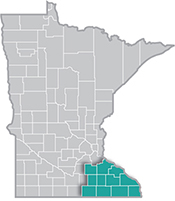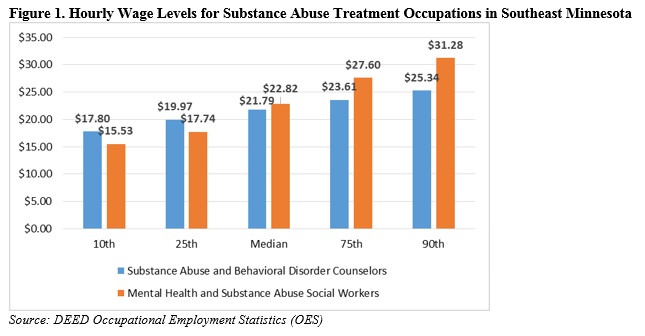 Southeast Minnesota is a health care and agricultural powerhouse. The region is home to the renowned Mayo Clinic and some of the world's most recognized food companies and brands.
Southeast Minnesota is a health care and agricultural powerhouse. The region is home to the renowned Mayo Clinic and some of the world's most recognized food companies and brands.
Advanced manufacturing is especially strong here, with machinery, chemicals, and electronics among the top products.
Want the freshest data delivered by email? Subscribe to our regional newsletters.
3/21/2017 9:47:04 AM
Substance abuse often carries a stigma leaving many people feeling ashamed and fearful of being judged. These feelings may hinder individuals from asking for help or getting out-patient or in-patient treatment. According to a 2016 report by the Minnesota Department of Human Services, 5.5 percent of Minnesota adults met the conditions to be considered as having an alcohol use disorder, and 2 percent were suffering from a drug use disorder. To put that into perspective, that’s over 230,000 individuals over the age of 18 struggling with alcohol problems and over 84,000 people battling drug abuse within the state, based on U.S. Census population estimates.
There is help available for Southeast Minnesota residents living with these afflictions. Organizations in the region employ approximately 320 substance abuse and behavioral disorder counselors and 180 mental health and substance abuse social workers, according to DEED’s Occupational Employment Statistics (OES) data. In fact, Southeast Minnesota is the second highest employing region in the state for substance abuse and behavioral disorder counselors, and the fourth highest for employing mental health and substance abuse social workers.
OES data show that these are relatively high paying occupations, with the median wages for these two occupations above the median wage across all occupations, which currently sits at $17.77 per hour. Both substance abuse and behavioral disorder counselors and mental health and substance abuse social workers earn around $22 per hour at the median (Figure 1).

Interestingly, DEED’s Career and Education Explorer tool shows that mental health and substance abuse social workers require a bachelor’s degree while substance abuse and behavioral disorder counselors just require a licensure. However, as seen in Figure 1, despite the difference in educational requirements, the median wages are relatively similar, differing by just over $1. Wages are actually lower at the 10th and 25th percentiles for social workers than for counselors; but they are much higher at the 75th and 90th percentiles, suggesting that the additional education pays off at the top end.
While there were very few vacancies in this career field in the most recent Job Vacancy Survey, both of these occupations remain in demand, holding four-star demand rankings, according to DEED’s Occupations in Demand (OID) data tool. That ranking means they may be good opportunities for job seekers to pursue.
Unfortunately, for those looking to gain employment in the Southeast region, right now may not be the best time to start looking for work, according to DEED’s Job Vacancy Survey (JVS) data. In the second quarter of 2016, there was no job vacancy data available for substance abuse and behavioral disorder counselors, and there were only seven vacancies for substance abuse social workers.
However, the data in Table 1 is still beneficial to those looking to start their education or career in this field, as it shows that none of the vacancies were part-time, temporary, or seasonal and 100 percent of the openings require post-secondary education. The median wage offers for the current vacancies for mental health and substance abuse social workers are higher than the 10th and 25th percentile wages earned by those currently working in this occupation, and also well above what is needed to meet the basic cost of living needs in the region.

Furthermore, the region is projected to see some openings in the future; however, these estimates are rather modest compared to some other occupations. As shown in Table 2, substance abuse and behavioral disorder counselors are projected to see approximately 70 total openings from 2014 to 2024, with 40 of those being replacement hires. Additionally, there is an expected 50 total openings for mental health and substance abuse social workers in the region, including 30 replacement hires. Both are expected to see rapid growth over this 10-year period.

Southeast Minnesota is experiencing a double victory when it comes to substance abuse careers. First, there are many people employed as substance abuse and behavioral disorder counselors and mental health and substance abuse social workers helping those suffering from drug and alcohol problems. Second, openings are projected for those looking for this career in the future.
Contact Mark Schultz.